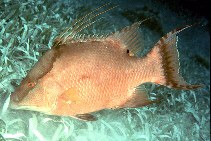http://www.fishbase.org/Summary/speciesSummary.php?genusname=Lachnolaimus&speciesname=maximus ---> http://192.134.151.83/Summary/speciesSummary.php?genusname=Lachnolaimus&speciesname=maximus
http://192.134.151.83/Summary/speciesSummary.php?genusname=Lachnolaimus&speciesname=maximus ---> https://fishbase.mnhn.fr/Summary/speciesSummary.php?genusname=Lachnolaimus&speciesname=maximus
https://fishbase.mnhn.fr/Summary/speciesSummary.php?genusname=Lachnolaimus&speciesname=maximus ---> https://fishbase.mnhn.fr/summary/Lachnolaimus-maximus.html
Lachnolaimus maximus, Hogfish : fisheries, gamefish, aquarium

You can
sponsor
this page
Common name (e.g. trout)
Genus + Species (e.g. Gadus morhua)
-

-
About this page
-
Languages
-
User feedbacks
-
Citation
-
Uploads
-
Related species
-


 Hogfish
Add your observation in
Fish Watcher
Upload your
photos
and
videos
Hogfish
Add your observation in
Fish Watcher
Upload your
photos
and
videos
Pictures
|
Videos |
Stamps, Coins Misc.
|
Google image
 Lachnolaimus maximus
Lachnolaimus maximus
Picture by
Randall, J.E.
Teleostei (teleosts) >
Eupercaria/misc
(Various families in series Eupercaria) >
Labridae
(Wrasses)
Etymology:
Lachnolaimus:
Greek, lachne, -es = more covered with hair than other + Greek, laimos = throat (Ref.
45335
)
.
More on author:
Walbaum
.
Environment: milieu / climate zone / depth range / distribution range
Ecology
Marine; reef-associated; depth range 3 - 30 m (Ref.
9710
). Subtropical; 46°N - 4°N, 98°W - 51°W
Western Atlantic: Nova Scotia (Canada), Bermuda, and northern Gulf of Mexico to northern South America.
Length at first maturity / Size / Weight / Age
Maturity: L
m
18.1
range ? - ? cm
Max length : 91.0 cm TL male/unsexed; (Ref.
7251
); common length : 35.0 cm TL male/unsexed; (Ref.
3726
); max. published weight: 11.0 kg (Ref.
36052
); max. reported age: 23 years (Ref.
93706
)
Dorsal
spines
(total): 14;
Dorsal
soft rays
(total): 11;
Anal
spines
: 3;
Anal
soft rays
: 10. Deep-bodied wrasse with a strongly arched dorsal profile. First 3 dorsal spines filamentous. Only wrasse with elongate dorsal spines and such a highly arched profile (Ref.
26938
). Color variable but generally mottled brownish red with a black spot at rear base of dorsal fin (Ref.
13442
).
A large and economically valuable species, monandric and a protogynous hermaphrodite (Ref.
93709
). Adults are found over open bottoms or coral reef areas (Ref.
5217
). Often encountered where gorgonians are abundant (Ref.
13442
). Feed mainly on mollusks, also crabs and sea urchins (Ref.
3726
). Flesh highly esteemed; marketed fresh and frozen (Ref.
3726
). Have been reared in captivity (Ref.
35420
).
Monandric (no primary males) , protogynous hermaphrodites. Sex change is postmaturation; it is initiated among individuals 30-40 cm LF (or 3-5 yrs) but was also observed in fish as large as 69.4 cm LF (13 yrs). Sex change occurred after one more spawning (as a female) seasons and requires several months to complete (Ref.74380). Harem spawner (Ref.74381). Spawning activity is characterised by the following event called 'spawning rush': 1) pectoral swim up, 2) tail swim, 3) swin alongsode and tilt, 4) release, 5) circle and display, and 6) swim down (Ref.
74381
).
Robins, C.R. and G.C. Ray
, 1986. A field guide to Atlantic coast fishes of North America. Houghton Mifflin Company, Boston, U.S.A. 354 p. (Ref.
7251
)
IUCN Red List Status (Ref.
130435
)
Vulnerable (VU)
(A2bd); Date assessed:
04 February 2009
CITES
Not Evaluated
Not Evaluated
Threat to humans
Reports of ciguatera poisoning (Ref.
7251
)
Human uses
Fisheries: minor commercial; gamefish: yes; aquarium: commercial
FAO - Fisheries:
landings
; Publication:
search
|
FishSource
|
Sea Around Us
More information
Countries
FAO areas
Ecosystems
Occurrences
Introductions
Stocks
Ecology
Diet
Food items
Food consumption
Ration
Common names
Synonyms
Metabolism
Predators
Ecotoxicology
Reproduction
Maturity
Spawning
Spawning aggregation
Fecundity
Eggs
Egg development
Age/Size
Growth
Length-weight
Length-length
Length-frequencies
Morphometrics
Morphology
Larvae
Larval dynamics
Recruitment
Abundance
BRUVS
References
Aquaculture
Aquaculture profile
Strains
Genetics
Electrophoreses
Heritability
Diseases
Processing
Nutrients
Mass conversion
Collaborators
Pictures
Stamps, Coins Misc.
Sounds
Ciguatera
Speed
Swim. type
Gill area
Otoliths
Brains
Vision
Tools
E-book
|
Field guide
|
Identification keys
|
Length-frequency wizard
|
Life-history tool
|
Point map
|
Classification Tree
|
Catch-MSY
|
Special reports
Check for Aquarium maintenance
|
Check for Species Fact Sheets
|
Check for Aquaculture Fact Sheets
Download XML
Summary page
|
Point data
|
Common names
|
Photos
Internet sources
AFORO (otoliths)
|
Aquatic Commons
|
BHL
|
Cloffa
|
BOLDSystems
|
Websites from users
|
Check FishWatcher
|
CISTI
|
Catalog of Fishes
:
genus
,
species
|
DiscoverLife
|
ECOTOX
| FAO - Fisheries:
landings
; Publication:
search
|
Faunafri
| Fishipedia |
Fishtrace
| GenBank:
genome
,
nucleotide
|
GloBI
|
GoMexSI
(interaction data)
|
Google Books
|
Google Scholar
|
Google
|
IGFA World Record
|
MitoFish
|
National databases
|
Otolith Atlas of Taiwan Fishes
|
Public aquariums
|
PubMed
|
Reef Life Survey
| Socotra Atlas |
Tree of Life
| Wikipedia:
Go
,
Search
| World Records Freshwater Fishing |
Zoological Record
Estimates based on models
Preferred temperature (Ref.
123201
): 23.7 - 28.2, mean 27.2 °C (based on 697 cells).
Phylogenetic diversity index (Ref.
82804
): PD
50
= 1.0000 [Uniqueness, from 0.5 = low to 2.0 = high].
Bayesian length-weight: a=0.02239 (0.01381 - 0.03628), b=2.95 (2.80 - 3.10), in cm total length, based on LWR estimates for this species & (Sub)family-body (Ref.
93245
).
Trophic level (Ref.
69278
): 4.2 ±0.0 se; based on diet studies.
Resilience (Ref.
120179
): Medium, minimum population doubling time 1.4 - 4.4 years (K=0.09; Fec=100,000; tm=1.1).
Fishing Vulnerability (Ref.
59153
): High vulnerability (59 of 100).
Price category (Ref.
80766
):
Very high
.
Nutrients (Ref.
124155
): Calcium = 15.1 [6.5, 32.9] mg/100g; Iron = 0.409 [0.207, 0.871] mg/100g; Protein = 19.2 [16.3, 21.6] %; Omega3 = 0.139 [0.072, 0.268] g/100g; Selenium = 16.8 [6.0, 39.7] μg/100g; VitaminA = 33.2 [7.5, 187.3] μg/100g; Zinc = 0.578 [0.359, 0.973] mg/100g (wet weight);
Back to Search
Random Species
Back to Top
Accessed through:
Not available
FishBase mirror site :
localhost
Page last modified by :
mrius-barile
- 20 July 2016
Fatal error
: Uncaught ArgumentCountError: Too few arguments to function checkEcotox(), 1 passed in /var/www/html/summary/speciessummary.php on line 2304 and exactly 3 expected in /var/www/html/includes/speciessummary.lib.php:2579 Stack trace: #0 /var/www/html/summary/speciessummary.php(2304): checkEcotox() #1 {main} thrown in
/var/www/html/includes/speciessummary.lib.php
on line
2579
|